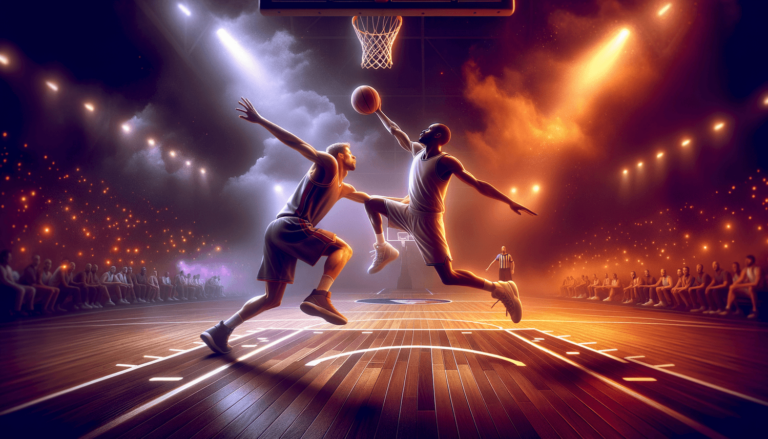
Unsportsmanlike Foul in Basketball: Definition and Examples
Written by: Basketball Universe
Last updated:

Welcome to the exciting world of basketball, where the action never stops, and the stakes are high. Dive with us into the uncharted territory of the unsportsmanlike foul, an often misunderstood, but crucial aspect of the game. As you embark on this slam-dunk adventure, you’ll unravel the definition, get up close and personal with real-life examples, and truly understand the impact of the unsportsmanlike foul in basketball. So, tighten your laces and let’s jump in, because you’re about to become a true master of this topic!
Unsportsmanlike Foul in Basketball: Definition and Examples
An unsportsmanlike foul in basketball, also known as a technical or flagrant foul, refers to a violation committed by a player, coach, or team that demonstrates unsportsmanlike conduct or excessive physicality. This type of foul often results in penalties such as free throws for the opposing team, ejection from the game, and possible suspension. Examples include taunting an opponent, making unnecessary contact against an airborne shooter, or deliberately pushing an opponent out of bounds.
Unlocking the Mystery of Unsportsmanlike Fouls
In order to leave no stone unturned in understanding unsportsmanlike fouls in basketball, let’s break them down into their core components: definition, types, consequences, and examples. We’ll navigate the sea of basketball rules seamlessly, arming you with knowledge to impress your friends, teammates, or even rivals on the court.
The ABC’s of Unsportsmanlike Fouls
Before diving deep into the realm of unsportsmanlike fouls, it’s important to grasp the basics of basketball fouls in general. In basketball, a foul refers to a rule violation committed by a player, resulting in a penalty. The game has two main types of fouls: personal fouls and technical fouls. Unsportsmanlike fouls, which we’ll focus on in this blog post, generally fall under the umbrella of technical fouls or a specific type of personal foul— the flagrant foul.
Tackling Technical Fouls
Technical fouls are committed due to unsportsmanlike conduct or other forms of undesirable behavior that typically don’t involve physical contact. Let’s dive into the subcategories of technical fouls.
Player Technical Fouls
These are committed by players who violate basketball rules for proper conduct or exhibit aggressive behavior. Examples include:
- Taunting or trash-talking an opponent.
- Disrespecting referees or contesting their decisions.
- Using abusive language or offensive gestures.
- Deliberately delaying the game by touching the ball after scoring.
Coach Technical Fouls
Yes, coaches aren’t immune to unsportsmanlike conduct! They can receive technical fouls for:
- Arguing excessively with referees.
- Disrespecting or using aggressive language towards players, referees, or other coaches.
- Requesting a timeout when there are none left.
Team Technical Fouls
A team may also receive a technical foul for violating certain basketball rules, such as:
- Having too many players on the court.
- Unauthorized players entering the game.
- A coach or other personnel leaving the bench area during an altercation on the court.
Flagrant Fouls: Crossing the Physicality Line
A flagrant foul is a severe personal foul that typically involves excessive force or unnecessary physical contact. There are two types of flagrant fouls:
Flagrant Foul 1 (FF1)
This is a personal foul involving excessive or unnecessary contact without intending to cause injury. Examples include:
- Swinging an elbow that makes contact with an opponent above the shoulders.
- Pushing or holding an opponent to prevent them from moving in a certain direction.
Flagrant Foul 2 (FF2)
This is a more severe form of FF1, typically involving excessive force with the intent to injure or harm an opponent. Examples include:
- Striking an opponent’s face with an elbow or forearm.
- Excessively pushing or throwing down an opponent to the ground.
The Repercussions of Unsportsmanlike Fouls
Unsportsmanlike fouls in basketball don’t go unpunished. Here’s a rundown of the consequences:
Technical Fouls
Being penalized with a technical foul comes with the following repercussions:
- One free throw awarded to the opposing team.
- Possible ejection from the game if a player, coach, or team accumulates a predetermined number of technical fouls (usually two).
Flagrant Fouls
Depending on the severity (FF1 or FF2), the following penalties apply:
- Two free throws awarded to the opposing team.
- Automatic ejection from the game for FF2 or for accruing two FF1s.
- Possible suspension for more severe infractions or a pattern of committing flagrant fouls.
Famous (or Infamous) Unsportsmanlike Foul Examples
Studying real-life examples can help solidify your understanding of unsportsmanlike fouls. Let’s revisit some memorable instances from basketball history.
Rasheed Wallace’s Technical Foul Record
Former NBA player Rasheed Wallace is infamous for his technical fouls. He set the single-season record during the 2000-2001 NBA season with an astounding 41 technical fouls. He was known for his confrontations with referees, resulting in numerous ejections.
Dennis Rodman’s Flagrant Foul on Scottie Pippen
In the 1991 NBA playoffs, one of the most notorious flagrant fouls occurred when the Detroit Pistons’ Dennis Rodman pushed the Chicago Bulls’ Scottie Pippen out of bounds during a layup attempt. Rodman was assessed a Flagrant Foul 1, and the incident fueled the already intense rivalry between the Pistons and the Bulls.
Draymond Green’s Suspension during the NBA Finals
During the 2016 NBA Finals, the Golden State Warriors’ Draymond Green was suspended for Game 5 due to accumulated flagrant fouls throughout the playoffs, including kicking the Oklahoma City Thunder’s Steven Adams in the groin and swiping at the Cleveland Cavaliers’ LeBron James. Green’s Game 5 absence was pivotal, as the Warriors ultimately lost the series to the Cavaliers after leading 3-1.
Unsportsmanlike Fouls: A Buzzer-Beater Summary
Having explored unsportsmanlike fouls from definition to consequence, and reviewing historical examples, you’re now well-versed in the intricacies of this fascinating basketball concept. With this newfound knowledge in hand, you’ll be able to appreciate the game even more and solidify your basketball expertise among fellow enthusiasts.
Preventing Unsportsmanlike Fouls
Equipped with knowledge of the unsportsmanlike foul, it’s now essential to understand how you can avoid committing them while playing basketball. Here are some practical tips to ensure that you play fair and with good sportsmanship:
Respect Referees and their Decisions
One of the key aspects of sportsmanship is to respect the authority of the referees officiating the game. Always remember that they are there to ensure fair competition and enforce basketball rules. Refrain from arguing or contesting calls and maintain a positive attitude, even if you believe they made a mistake. Reacting negatively contributes to a toxic atmosphere on the court.
Good Communication with Teammates
Being a great teammate goes beyond sharing the ball and playing excellent defense. Encourage open communication with your teammates, allowing them to express their emotions and frustrations in a healthy and respectful way. By cultivating a supportive team environment, you reduce the risk of unsportsmanlike behavior on the court.
Keep Emotions in Check
Basketball is a passionate game, but letting your emotions get the better of you can lead to unsportsmanlike fouls. By focusing on maintaining self-control and staying composed, you’ll be more likely to exhibit good sportsmanship and make better decisions on and off the court.
Avoid Trash-Talking and Taunting
Competitiveness is an inherent part of sports, but there’s a fine line between friendly banter and indulging in disrespectful taunting or trash-talking. Respecting your opponents is key in maintaining a high standard of sportsmanship, so enjoy the thrill of competition without crossing the line.
Educating the Next Generation of Players
The role of coaches, parents, and mentors in teaching young athletes about the importance of sportsmanship in basketball is paramount. Here are some recommendations for fostering a respectful environment:
Lead by Example
Young players often look up to their role models, so it’s crucial for coaches and parents to set a positive example by exhibiting sportsmanlike behavior at all times, both on and off the court. By practicing what they preach, mentors can help reduce the likelihood of young athletes committing unsportsmanlike fouls.
Teach the Rules and Encourage Fair Play
In order to ingrain the value of following basketball rules, it’s essential for coaches to thoroughly educate their players on the different aspects of the game. This includes explaining and demonstrating the dos and don’ts on the court, emphasizing the importance of fair play, and actively discouraging unsportsmanlike behavior.
Establish Consequences for Unsportsmanlike Conduct
Setting up consequences, such as removing playing time, running extra laps, or sitting out a game, can help deter young athletes from engaging in unsportsmanlike conduct. The impact of these lessons will serve them well throughout their basketball journey and beyond.
Develop Teamwork and Sportsmanship
It’s essential to foster a team-first mentality that emphasizes cooperative, selfless play and mutual respect between teammates. When players understand that they are part of something bigger than themselves, they are less likely to engage in unsportsmanlike behavior.
FAQ: Find Answers to Your Unsportsmanlike Foul Queries
Got burning questions about unsportsmanlike fouls in basketball? Look no further! Our FAQ section covers the most common queries related to this riveting topic, providing you with concise and informative answers to satiate your curiosity.
1. What is the difference between a technical foul and a flagrant foul?
A technical foul is generally non-physical and occurs due to unsportsmanlike conduct or undesirable behavior. A flagrant foul is a more severe personal foul involving excessive force, unnecessary physical contact, or an intent to harm an opponent.
2. Can a coach receive a technical foul?
Yes, a coach can be penalized with a technical foul for a variety of reasons, such as excessively arguing with referees, using aggressive language towards players or referees, or requesting a timeout when there are none left.
3. How many technical fouls lead to ejection from the game?
In most basketball leagues, a player, coach, or team member is ejected from the game after receiving two technical fouls.
4. What is the penalty for a technical foul?
The penalty for a technical foul typically includes one free throw awarded to the opposing team.
5. What are the consequences of a flagrant foul?
The consequences of a flagrant foul (FF1 or FF2) can include two free throws awarded to the opposing team, automatic ejection from the game (for FF2 or two accumulated FF1s), and possible suspension for more severe infractions or a pattern of committing flagrant fouls.
6. What should I do if a referee calls an unsportsmanlike foul on me?
If a referee calls an unsportsmanlike foul on you, remain composed and respectful towards the referee. Remember that arguing excessively or disrespecting the official’s decision may result in additional penalties, like more technical fouls or ejection from the game.
7. Can an unsportsmanlike foul be rescinded or overturned?
In certain cases, a referee may review an unsportsmanlike foul, such as a flagrant foul, using available video replays or consulting with other officials. If they deem the foul to be less severe than initially assessed, they can modify the call or rescind the penalty.
8. How can I avoid committing unsportsmanlike fouls?
To avoid committing unsportsmanlike fouls, respect the referees and their decisions, maintain good communication with teammates, keep your emotions in check, and refrain from trash-talking or taunting your opponents.
9. How can coaches teach young athletes about unsportsmanlike fouls and sportsmanship?
Coaches can teach young athletes about sportsmanship and unsportsmanlike fouls by leading by example, educating players on the rules and encouraging fair play, establishing consequences for unsportsmanlike conduct, and fostering teamwork and camaraderie within the team.
10. Are unsportsmanlike fouls treated differently in amateur or youth leagues?
Amateur or youth leagues may have different rules, enforcement levels, and penalties for unsportsmanlike fouls. It’s important to check the specific regulations for each league and remain up-to-date on their policies regarding unsportsmanlike conduct.
Featured Posts
- No pillar pages found.





